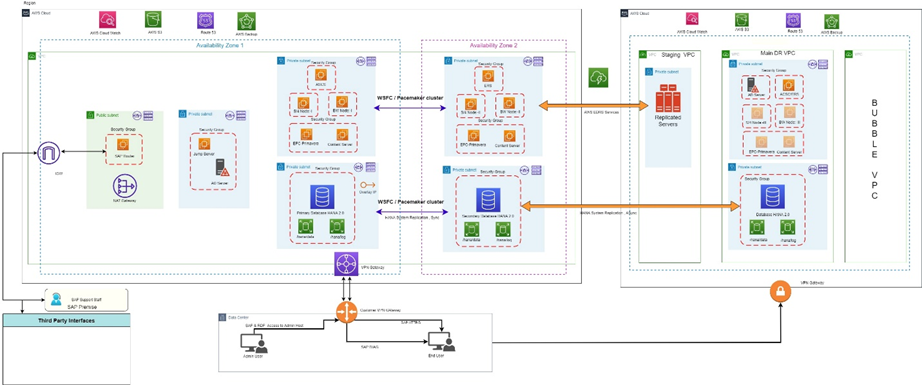Disaster Recovery enables organizations to take preventive measures to ensure the business continues to function uninterrupted despite facing a disaster situation. By minimizing the effects of a jolt and recover any lost assets, it includes all the objectives and procedures for a quick recover after a cyber-attack, lost data, or damaged hardware. Disaster Recovery can be a key component for Business Continuity plan for any mission-critical and business-critical applications such as SAP.
How Disaster can happen, what are the scenarios
- Natural disasters
- Human errors
- Cyber-attacks
- Hardware failures
- Power outages
- Software failures
It is important for organizations to identify potential disaster scenarios and have a disaster recovery plan in place to minimize the impact of these scenarios. This includes creating backups of critical data, regularly testing disaster recovery plans, and ensuring that IT infrastructure is configured properly to prevent disasters from occurring in the first place. By preparing for potential disasters, organizations can minimize downtime, ensure business continuity, and protect against potential data loss.
What impact Disaster can bring to the business
Disasters, whether natural or man-made, can have a significant impact on businesses, leading to significant losses in terms of revenue, reputation, and even data. Some of the most common impacts of disasters on businesses include:
- Infrastructure damage
- Downtime
- Data loss
- Supply chain disruptions
- Reputation damage or Dent on brand image
- Financial/business loss
How Disaster impact can be mitigated
Develop a disaster recovery plan: Develop a comprehensive disaster recovery plan that outlines the steps to be taken in the event of a disaster. The plan should include a list of critical systems and data, backup and recovery procedures, and contingency plans for different scenarios.
- Regular backups
- Redundant Infrastructure
- Regular DR test
- Enhancing cybersecurity measures
- Adequate training to the employees
- Maintain communication
By preparing for disasters, organizations can minimize the impact of these events on their business. This can include creating a disaster recovery plan, replicating data to a secondary location, automating the disaster recovery process, and storing data backups in a highly available and scalable object storage solution. With these preparations in place, organizations can ensure that their critical systems remain available and operational, even in the event of a disaster, helping them maintain business continuity.
Tools, Technologies, Partnership to Address Disaster scenario
- Disaster recovery tools or DraaS.
- Backup and restore tools like AWS Bakint, Commvault, Veeme Backup, Rackware, Zerto, Carbonite etc.
- App or OS specific tools
- Look for seasoned partner who can prepare and execute the effective DR and BC plan, which addresses the compliance requirement of the organization.
Impeccable DR strategy – Points to keep in mind
- High availability is not disaster recovery
- Plan for overall recoveries – Smaller and large scale, anticipate the changes.
- Always assure the recovery data is encrypted
- Define RTO/RPO based on
- Business requirement & Impact
- Data volume
- Recovery complexity
- Recovery location
- Primary site configuration
- Bandwidth
- Replication strategy
- Multi-site deployment
- Testing
- Security
- Monitoring and alerting
- Automation
Best ways to recover your SAP workload
There are several ways to recover SAP applications on AWS during a disaster. Here are some common methods:
Replication and failover: This involve replicating SAP applications and data to another AWS region or Availability Zone and setting up a failover mechanism to automatically switch to the replicated system in the event of a disaster. AWS offers several services such as AWS EDRS, S3, Amazon Route 53 which can be used to implement replication and failover mechanisms for SAP applications.
Backup and restore: This involves creating regular backups of SAP applications and data, which can be used to restore systems in the event of a disaster. AWS offers several backup and recovery services, such as Amazon S3, Amazon EBS, and AWS Backup, which can be used to backup and restore SAP applications and data.
Multi-site deployment: This involves deploying SAP applications and data across multiple AWS regions or Availability Zones, to ensure that systems remain operational in the event of a disaster. AWS offers several services such as High Availability, S3 and Amazon Route 53, which can be used to implement multi-site deployments for SAP applications.
Disaster recovery as a service (DRaaS): DRaaS involves using a third-party service provider to manage and maintain disaster recovery systems and processes. AWS offers several DRaaS solutions, such as AWS Disaster Recovery, which provides fully-managed disaster recovery solutions for SAP applications.
Automate disaster recovery: Organizations can automate the disaster recovery process for their SAP systems by using AWS services, such as AWS CloudFormation, AWS Lambda, and Amazon CloudWatch.

Figure: Sample SAP HA- DR System Architecture on AWS
SAP Native tools: –
HSR:
HSR replicates data between two SAP HANA systems running in different AWS Availability Zones or regions. In the event of a disaster, HSR automatically fails over to the secondary system, which can be promoted to become the primary system, and resume processing.
- HSR uses synchronous or Asynchronous replication to ensure that data is replicated between the primary and secondary systems in real-time, with zero data loss.
- To implement HSR, organizations must configure a primary SAP HANA system and a secondary SAP HANA system running on AWS and configure HSR to replicate data between them. HSR requires a high-speed network connection between the primary and secondary systems to ensure that data is replicated in real-time.
- HSR is a native solution provided by SAP and is fully supported for SAP applications running on AWS. It provides a robust and reliable disaster recovery solution for SAP applications running on AWS and can help organizations minimize the impact of any downtime or disruptions.
SWPM (Software provisioning Manager) for SAP DR
The Software Provisioning Manager (SWPM) tool is a critical tool for setting up SAP systems and applications for disaster recovery purposes. The SWPM tool is used to perform installations, updates, and system copies of SAP systems and applications. In the context of SAP DR, the SWPM tool is used to create a copy of the production SAP system on the DR site.
The SWPM tool can be used to perform a variety of tasks related to setting up the DR environment, including:
Installing the SAP system on the DR site: The SWPM tool can be used to install the SAP system on the DR site, including the application server, database server, and other necessary components.
Creating a copy of the production SAP system: The SWPM tool can be used to create a copy of the production SAP system on the DR site. This involves copying all the data from the production system to the DR system, ensuring that the DR system is an exact replica of the production system.
Updating the DR system: The SWPM tool can be used to update the DR system with the latest patches, service packs, and other updates to ensure that it is up-to-date and capable of handling failover in the event of a disaster.
Configuring the DR system: The SWPM tool can be used to configure the DR system to ensure that it is properly integrated with the organization’s existing IT infrastructure and systems.
Overall, the SWPM tool is a critical tool for setting up SAP systems and applications for disaster recovery purposes. It enables organizations to create a copy of their production SAP system on the DR site, ensuring that they can recover quickly and effectively in the event of a disaster or disruption.
How Yash Technologies is helping organizations to formulate their DR strategy.
We enable organizations to leverage the power of cloud to unlock the business potentials. With more than 27+ years of experience and our global presence, we are serving some of the most valuable organizations in the world.
With a backing of more than 1000 cloud professionals, hundreds of cloud certified resources, AWS advance consulting partner with SAP & DevOps competency make us partner of choice for most of the fortune 500 companies.
We believe every company has a unique purpose and growth journey. Organization’s success story will be defined by their strategy to enable agility, innovation, and resilience. We empower you to scale rapidly, seize emerging opportunities, and future-proof your business.
Our expertise in cloud migration & modernization, building robust DR strategy and focus on customer success make it a strong partner for clients looking to leverage AWS services for their digital transformation initiatives and accelerating cloud services adoption to deploy and integrate AWS cloud, we also leverage our technical expertise in SAP and AWS to define a suitable DR strategy for your esteemed organization considering below points:
- Define RPO and RTO based on your business needs.
- Suggest a robust DR architecture
- Best suited replication method, after understanding your currently architecture, application versions and database.
- Conducting regular recovery/ DR test
- Governance & compliance and Monitoring & automation
As a trusted AWS partner, we focus on ensuring a hassle-free cloud transformation journey. Our highly regarded cloud methodology provides improved agility, reduced operational costs, lower TCO, and minimum downtime.





